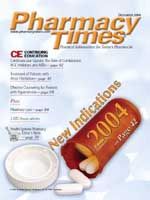Publication
Article
Pharmacy Times
Staying Well with Herbs and Vitamins
Author(s):
With the ever-increasing awarenessof the need for healthpromotion, more people areturning to OTC dietary and nutritionalsupplements to preserve and prolongtheir wellness. A seemingly endless supplyof available products can puzzle boththe health care professional and thepatient. Knowledge on the part of thepharmacist of the wellness products available,their indications, and the patientpopulation for which they are appropriatewill help to minimize potential questions.
Antioxidant Supplements
The antioxidant vitamins C, E, andbeta-carotene have attracted mediaattention for their health-promotingactivities. Antioxidants are thought toact as scavengers for free radicals, thuspreventing cell damage. Vitamin E, afat-soluble antioxidant, has been promotedto prevent coronary heart disease,cancer, and cataracts; however, itsefficacy in disease prevention warrantsfurther study. The RecommendedDietary Allowance of vitamin E is 22international units (IU), and deficienciesare rare.1
Vitamins C and E have gained recentpopularity for their role in the preventionof oxidative changes related toAlzheimer's disease.2 Research suggeststhat cognitive loss may be due to oxygenfree radicals, and in animal studiesantioxidant vitamin supplementsseemed to increase neuron survivaland synaptic response.3 Although furtherstudy is needed, it appears thatusing vitamins C and E in combinationtherapy may help reduce theprevalence and incidence of Alzheimer'sdisease.2 Other studies suggestvitamin C and E supplementation toprotect against vascular dementia andto improve cognitive function.4
Similarly, ginkgo supplements mayplay a role in the treatment of memoryproblems and dementia. The activeconstituents are believed to act as freeradical scavengers, thus mediating theoxidation and cell damage seen inAlzheimer's disease. Other proposedmechanisms of ginkgo includeincreased blood flow through smallvessels, vasoregulatory effects, increasedtolerance to hypoxia, neuroprotectiveproperties, inhibition ofphospholipase A, and decreased capillaryfragility. Side effects of ginkgo arerare and include nausea, headache,stomach problems, diarrhea, allergy,anxiety, and sleep disturbances. Gingkohas antiplatelet properties, and patientsreceiving anticoagulation therapyshould be cautioned against its use.5
Supplements for Well-being
Ginseng has been advocated for itschronic strengthening effects; however,clinical data have yet to show a relationship.Its mechanism is complicatedand is believed to result incorticosteroid-like actions, hypoglycemicactivity, and neurotransmitteractivity. Estrogenic adverse effectshave been reported. Ginseng alsoexhibits antiplatelet activity, requiringcaution in anticoagulated patients.5Daily health maintenance doses rangefrom 250 to 500 mg for up to 3months. Side effects have not beenclearly established but may includesleeplessness, increased blood pressure,headache, nausea, and vomiting.6
Prior to its 1998 introduction in theUnited States, S-adenosyl-methionine(SAM-e) was widely used in Europe forthe treatment of arthritis and depression.SAM-e is naturally found throughoutthe body's tissues and fluids butappears to be more concentrated in thebrain and liver. Some patients withdepression, Alzheimer's disease, dementia,and Parkinson's disease havebeen found to have below-average levelsof SAM-e in their cerebrol spinalfluid.7 SAM-e levels also may be low inpatients with folate or vitamin B12 deficiencies.5 Patients with a history ofbipolar disorder should not use SAM-e,because it may induce mania. A dosageof 400 mg per day is recommended inthe treatment of depression, with up to1600 mg per day in severely depressedpatients. Arthritis patients typicallyrequire 400 mg twice a day for 2 weeks,followed by 400 mg daily.7 Side effectsare minor and include insomnia, nervousness,appetite suppression, constipation,headaches, palpitations, nausea,dry mouth, sweating, and dizziness.5Sexual dysfunction and weight gainhave not been reported.7
Maintaining Strength
Glucosamine and chondroitin sulfatehave been marketed in conjunctionfor the treatment of osteoarthritis.Glucosamine is a cartilage componentand may play a role in cartilage metabolicresponses. In the collagen matrix,chondroitin sulfate appears to increaseproteoglycan concentration and todecrease collagenolytic activity.8 A 3-year, randomized, placebo-controlledstudy of 212 patients found minimaljoint space loss in the active treatmentgroup taking 1500 mg of glucosaminedaily. Advocates of nutraceuticals promoteglucosamine as being safer thantraditional nonsteroidal anti-inflammatorydrugs for long-term treatmentof osteoarthritis.9
Calcium affects many aspects of thebody, including muscle and blood vesselcontractility, hormone and enzymesecretion, and neurotransmission. Itsimpact on bone mineral density and itsrole in preventing osteoporosis are bothwell known and well promoted. Foradults between the ages of 19 and 50,the National Institutes of Health recommendsconsuming 1000 mg of calciuma day; adults 51 years and above arerecommended to take 1200 mg a day.The most popular formulations of calciumsupplements are calcium carbonateand calcium citrate. The carbonate formulationowes its popularity to beinginexpensive and easy to obtain; however,the citrate form is better absorbedby the gastrointestinal tract. Sideeffects of calcium include constipation,flatulence, and bloating and can beminimized by spreading the dosesthroughout the day.10
Vitamin D is partnered with calciumin the fight against osteoporosis. Itsmain role is to maintain serum calciumand phosphorus levels and to promotecalcium absorption, which results inbone strengthening and maintenance.Vitamin D can be synthesized in thebody after exposure to sunlight, as wellas being found in foods and supplements.Adults aged 19 to 50 are recommendedto consume 200 IU of vitaminD daily, those aged 51 to 70 require400 IU daily, and those aged 71 andabove require 600 IU daily.11
Whereas calcium supplementationhas been shown to be significant in theprevention of osteoporosis, recentresearch suggests that potassium andmagnesium supplementation mayplay a role in bone mineral density.Low potassium intake promotes urinarycalcium excretion; conversely,increased dietary potassium results incalcium retention by the kidneys. Magnesiumaffects calcium balance in thebone and is necessary for calciummetabolism. Women with osteoporosishave demonstrated low magnesiumcontent, which is reflected in brittlerbone crystals than in women with adequatemagnesium levels.12
Summary
The array of dietary supplementsand their often-ambiguous indicationspresent challenging situations for thehealth care provider. Preparation andeducation will guide both the patientand the provider in selecting an appropriateagent.
Dr. Holmberg is a pharmacist with Phoenix Indian Medical Center, Phoenix, Ariz. The opinions expressed are those of the author and not necessarily of any goverment agency.
For a list of references, send a stamped, self-addressed envelope to: References Department, Attn. A. Stahl, Pharmacy Times, 241 Forsgate Drive, Jamesburg, NJ 08831; or send an e-mail request to:[email protected].

Newsletter
Stay informed on drug updates, treatment guidelines, and pharmacy practice trends—subscribe to Pharmacy Times for weekly clinical insights.






